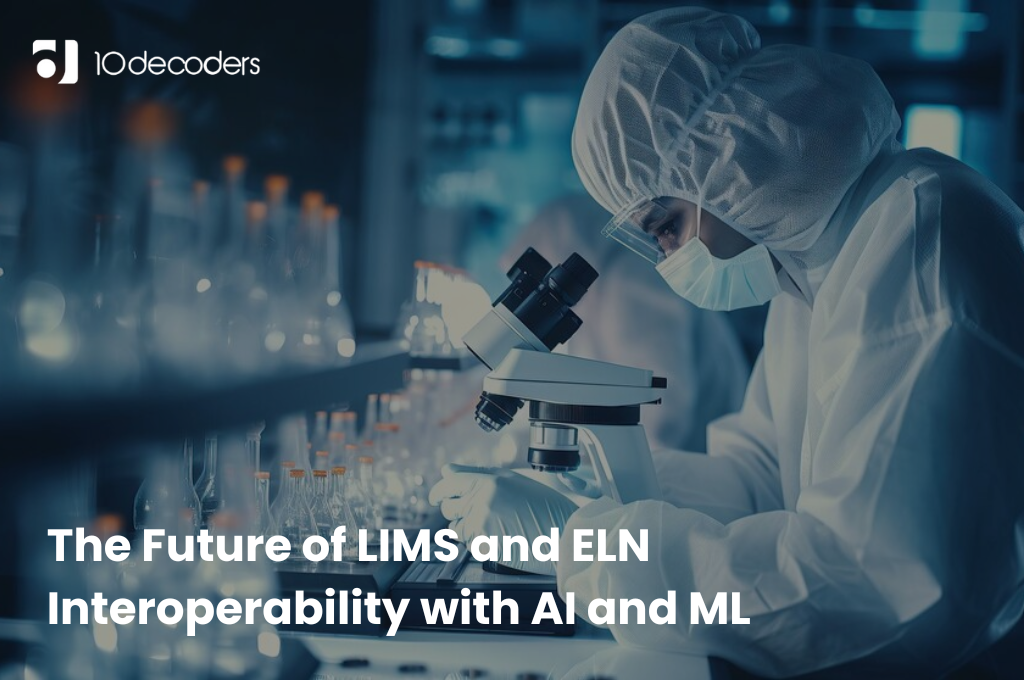The Future of LIMS and ELN Interoperability with AI and ML
In the digitised landscape of modern research, Laboratory Information Management Systems (LIMS) and Electronic Laboratory Notebooks (ELNs) stand as the cornerstones of data acquisition and management. Yet, their true potential remains shackled by siloed existence, hindering holistic laboratory workflows and impeding groundbreaking discoveries. This fragmented reality is on the precipice of a transformative shift, spearheaded by the potent duo of Artificial Intelligence (AI) and Machine Learning (ML). These technologies are poised to dismantle the data walls separating LIMS and ELNs, paving the way for seamless interoperability and unlocking a wealth of hidden insights.
From Isolation to Integration: Breaking Down the Data Walls
Traditionally, LIMS and ELNs have operated as independent entities, each fulfilling distinct, yet isolated, roles. LIMS meticulously tracks samples and inventory, while ELNs diligently document experimental steps and observations. This disjointed landscape fosters data redundancy, inconsistencies, and limited analysis capabilities. The ideal scenario? Orchestrating a seamless flow of information between these systems, creating a comprehensive narrative of laboratory processes and enabling the extraction of valuable trends and patterns.
AI and ML: The Interoperability Bridge
This is where AI and ML step onto the stage as the crucial interoperability bridge. Leveraging their data-driven prowess, these technologies can break down the silos separating LIMS and ELNs, weaving a tapestry of interconnected information. Natural Language Processing (NLP) algorithms can delve into the rich text of ELN entries, automatically associating observations with corresponding samples and analyses in the LIMS. Conversely, LIMS’ structured metadata can enrich ELN entries, enhancing context and ensuring data integrity.
AI and ML emerge as the architects of a new era, ready to bridge the gap between LIMS and ELNs. These technologies act as digital translators, deciphering the language of both systems and weaving a tapestry of interconnected data. Here’s how they work their magic
- Natural Language Processing (NLP): This AI technique unlocks the secrets within ELNs’ free-text entries. NLP extracts key information like sample IDs, experimental conditions, and results, automatically linking them to corresponding samples and analyses in the LIMS.
- Machine Learning: Powerful algorithms learn from the rich data within both systems, identifying patterns and relationships that might escape even the most trained eye. This enables predictive maintenance of instruments, anomaly detection in experimental data, and even automated generation of reports and insights.
Beyond Synchronisation: AI and ML as Engines of Insight
However, the value of this interoperability extends far beyond mere data synchronisation. AI and ML can transform these interconnected systems into potent engines of scientific discovery. Predictive algorithms can anticipate instrument failure, ensuring preventative maintenance and safeguarding precious experiments. Multivariate analysis can identify subtle correlations between experimental parameters and outcomes, rewriting the playbook of scientific optimization. Machine learning models can flag anomalous results and suggest further investigations, acting as vigilant guardians against experimental pitfalls.
Current Landscape: Fragmented Data, Limited Insights
Traditionally, LIMS and ELNs have lived separate lives, their data locked away like priceless artefacts in forgotten museums. This fragmentation creates several challenges
- Redundancy and inconsistencies: Scientists waste time duplicating data entry across systems, leading to inconsistencies and potential errors.
- Limited analytical capabilities: Disconnected data hinders comprehensive analysis, obscuring hidden patterns and correlations that could unlock groundbreaking discoveries.
- Inaccessible knowledge: Valuable insights buried within ELNs remain inaccessible to LIMS, hampering effective sample management and workflow optimization.
Evolving Melodies: Future Trends in Interoperability
The future of LIMS and ELN interoperability with AI and ML is a captivating melody still in its early movements. Here are some of the exciting trends waiting to be played
- Deep Learning for Anomaly Detection: Deep learning algorithms, with their ability to discern complex patterns, can delve deeper into data, uncovering subtle anomalies that might escape even the most trained human eye. This can revolutionise quality control and usher in an era of proactive error prevention.
- Federated Learning for Shared Intelligence: By collaboratively learning from anonymized data across geographically dispersed laboratories, AI models can glean insights from a vast tapestry of experimental experiences, propelling scientific progress at an unprecedented pace.
- Explainable AI for Demystified Decisions: The “black box” nature of AI can be illuminated with explainable AI techniques, fostering trust and empowering scientists to confidently navigate the landscape of AI-derived insights.
Challenges and Opportunities: Navigating the Interconnected Future
While the future of interoperability holds immense promise, it is not without its challenges. Addressing data security concerns, ensuring seamless integration with existing systems, and providing adequate training for scientists are crucial steps towards successful implementation. However, the potential benefits far outweigh the challenges. By embracing this transformative future, laboratories can unlock a new era of efficiency, insight, and discovery.
Conclusion
The convergence of LIMS and ELN interoperability with AI and ML is not simply about data harmonisation; it’s about composing a symphony of scientific progress. By weaving together the meticulous data management of LIMS and ELNs with the intelligent insight of AI and ML, we can orchestrate a future where hidden trends sing their secrets and laboratories become crucibles of intelligent experimentation. So, let us take up the baton, conductors of scientific progress, and prepare to lead the orchestra of interconnected data towards a future brimming with groundbreaking discoveries.



